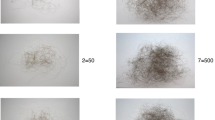Abstract
Although women’s body hair removal is strongly normative across contemporary Western cultures, only two studies of ‘mundane’ depilation have been published, and they were based on data from the US (Basow, 1991) and Australia (Tiggemann & Kenyon, 1998), respectively. The present survey, comprised of a sample of 678 women, extends this work. We investigated UK practices, a wider array of body regions and removal methods, and the relationship between depilation and age. Over 99% of participants reported removing some hair, most commonly from the underarms, legs, pubic area, and eyebrows. Shaving and plucking were the most common removal methods. Significant relationships between age and leg, pubic, and facial depilation were found. Results document the normativity of hair removal, and we argue that hair removal is part of the taken-for-granted work of producing an ‘acceptable’ femininity.
Similar content being viewed by others
References
Barth, J. H., Catalan, J., Cherry, C. A., & Day, A. (1993). Psychological morbidity in women referred for treatment of hirsutism. Journal of Psychosomatic Research, 37, 615–619.
Bartky, S. L. (1998). Foucault, femininity, and the modernization of patriarchal power. In R. Weitz (Ed.), The politics of women’s bodies: Sexuality, appearance, and behaviour (pp. 25–45). Oxford: Oxford University Press.
Basow, S. A. (1991). The hairless ideal: Women and their body hair. Psychology of Women Quarterly, 15, 83–96.
Basow, S. A., & Braman, A. C. (1998). Women and body hair: Social perceptions and attitudes. Psychology of Women Quarterly, 22, 637–645.
Bem, S. L. (1978/1987). Probing the promise of androgyny. In M. R. Walsh (Ed.), The psychology of women: Ongoing debates (pp. 206–225). New Haven, CT: Yale University Press.
Bornstein, K. (1994). Gender outlaw: On men, women, and the rest of us. New York: Routledge.
Brace, N., Kemp, R., & Snelgar, R. (2000). SPSS for psychologists: A guide to data analysis using SPSS for Windows. London: Macmillan.
Brownmiller, S. (1984). Femininity. London: Hamish Hamilton.
Chapkis, W. (1986). Beauty secrets: Women and the politics of appearance. Boston: South End Press.
Cooper, W. (1971). Hair: Sex society symbolism. London: Aldus Books.
Cramer, D. (1994). Introducing statistics for social research: Step-by-step calculations and computer techniques using SPSS. London: Routledge.
Fausto-Sterling, A. (2000). Sexing the body: Gender politics and the construction of sexuality. New York: Basic Books.
Ferrante, J. (1988). Biomedical versus cultural constructions of abnormality: The case of idiopathic hirsutism in the United States. Culture, Medicine and Psychiatry, 12, 219–238.
Ferriman, D., & Gallwey, J. D. (1961). Clinical assessment of body hair growth in women. Journal of Clinical Endocrinology and Metabolism, 21, 1440–1447.
Firth, R. (1973). Hair as private asset and public symbol. In R. Firth (Ed.), Symbols public and private (pp. 262–298). London: Allen and Unwin.
Freedman, R. (1986). Beauty bound. Lexington, MA: Lexington Books.
Gay and lesbian information. (2002). Retrieved November 25, 2003, from http://www.avert.org/hsexul.htm.
Gillette pins hopes on its new Venus women’s shaving system. (2000, November 11). Retrieved June 10, 2003, from http://reports.mintel.com/sinatra/mintel/databases.
Goodison, L. (1992). Moving heaven and earth: Sexuality, spirituality and social change. London: Pandora Press.
Great Britain Central Statistical Office & Great Britain Office for National Statistics. (2002). Social trends (p. 32). London: HMSO.
Greer, G. (1970). The female eunuch. London: MacGibbon and Kee.
Hope, C. (1982). Caucasian female body hair and American culture. Journal of American Culture, 5, 93–99.
Howell, D. C. (1997). Statistical methods for psychology (4th ed.). Belmont, CA: Duxbury Press.
Howitt, D., & Cramer, D. (2000). An introduction to statistics for psychology: A complete guide for students. London: Prentice Hall/Harvester Wheatsheaf.
Johnson, R. (2002, May 18). Bush whacked. The Spectator. Retrieved November 25, 2003, from http://www.spectator.co.uk/article.php3?table=old§ion=current&issue=2002-12-07&id=1872&searchText=.
Kitzinger, C., & Willmott, J. (2002). ‘The thief of womanhood‘: Women’s experiences of polycystic ovarian syndrome. Social Science and Medicine, 54, 349–362.
Rabinowitz, S., Cohen, R., & Le Roith, D. (1983). Anxiety and hirsutism. Psychological Reports, 53, 827–830.
Schweigert, W. A. (1994). Research methods and statistics for psychology. Pacific Grove, CA: Brooks/Cole.
Simpson, N. (1986). Unwanted hair. British Medical Journal, 293, 348–349.
Synnott, A. (1993). The body social: Symbolism, self and society. London: Routledge.
Tiggemann, M., & Kenyon, S. J. (1998). The hairlessness norm: The removal of body hair in women. Sex Roles, 39, 873–885.
Toerien, M., & Wilkinson, S. (2003). Gender and body hair: Constructing the feminine woman. Women’s Studies International Forum, 26(4), 333–344.
Toerien, M., & Wilkinson, S. (2004). Exploring the depilation norm: A qualitative questionnaire study of women’s body hair removal. Qualitative Research in Psychology, 1, 69–92.
Whelehan, I. (2000). Overloaded: Popular culture and the future of feminism. London: Women’s Press.
Wolf, N. (1991). The beauty myth: How images of beauty are used against women. New York: Anchor Books.
Author information
Authors and Affiliations
Corresponding author
Rights and permissions
About this article
Cite this article
Toerien, M., Wilkinson, S. & Choi, P.Y.L. Body Hair Removal: The ‘Mundane’ Production of Normative Femininity. Sex Roles 52, 399–406 (2005). https://doi.org/10.1007/s11199-005-2682-5
Issue Date:
DOI: https://doi.org/10.1007/s11199-005-2682-5




